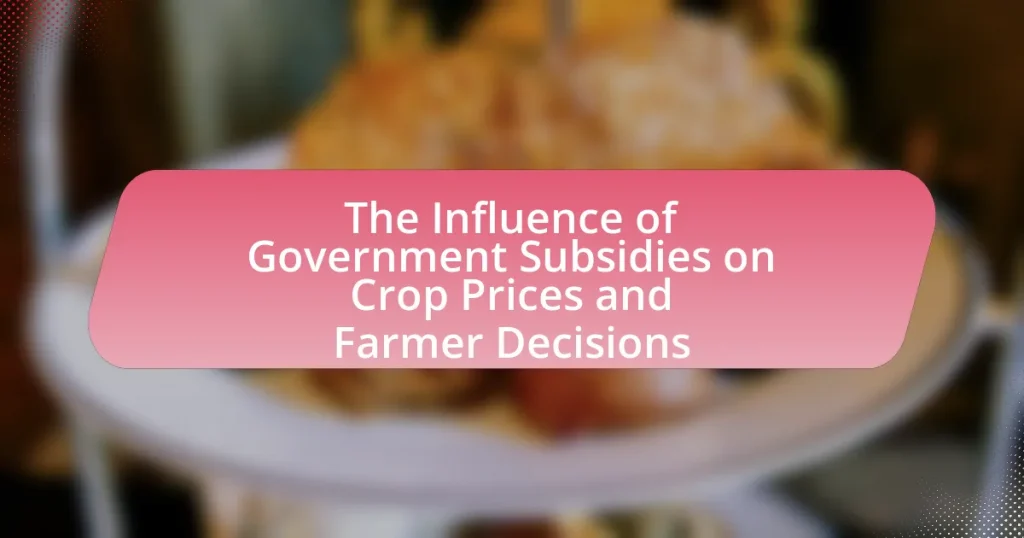Government subsidies are financial aids provided by the government to support specific sectors, particularly agriculture, with the aim of promoting economic stability and ensuring the availability of essential goods. This article examines the impact of these subsidies on agricultural markets, including their influence on crop prices, farmer decisions, and production levels. It details the types of subsidies available, the economic factors driving their implementation, and the potential drawbacks of reliance on government support. Additionally, the article explores how subsidies can alter supply and demand dynamics, affect long-term farming strategies, and the best practices farmers can adopt to navigate subsidy programs effectively.

What are Government Subsidies and Their Purpose?
Government subsidies are financial aids provided by the government to support specific sectors, industries, or economic activities. Their primary purpose is to promote economic stability, encourage production, and ensure the availability of essential goods and services. For instance, in agriculture, subsidies can help stabilize crop prices, making it easier for farmers to manage production costs and maintain their livelihoods. According to the U.S. Department of Agriculture, government subsidies in agriculture amounted to approximately $20 billion in 2020, demonstrating their significant role in influencing farmer decisions and market dynamics.
How do government subsidies impact agricultural markets?
Government subsidies significantly impact agricultural markets by influencing crop prices and farmer decisions. These financial aids can lower production costs, leading to increased supply and potentially lower market prices for consumers. For instance, in the United States, the Farm Bill allocates billions in subsidies, which can stabilize farmers’ income and encourage them to produce more, thus affecting overall market dynamics. Research indicates that countries with substantial agricultural subsidies, such as the European Union, often see distorted market prices compared to those without such support, as subsidies can lead to overproduction and surplus in certain crops.
What types of government subsidies are available for farmers?
Government subsidies available for farmers include direct payments, crop insurance subsidies, conservation program funding, and disaster assistance. Direct payments provide farmers with financial support based on historical production levels, while crop insurance subsidies help mitigate risks associated with crop failures. Conservation program funding incentivizes sustainable farming practices, and disaster assistance offers relief during adverse weather events. These subsidies are designed to stabilize farm income, promote agricultural sustainability, and ensure food security, as evidenced by the U.S. Department of Agriculture’s reports on the economic impact of these programs.
How do subsidies influence crop production levels?
Subsidies significantly increase crop production levels by providing financial support to farmers, which lowers their production costs. This financial assistance encourages farmers to cultivate more land and invest in better technology and inputs, leading to higher yields. For instance, in the United States, the Farm Bill allocates billions in subsidies, which has been shown to boost the production of major crops like corn and soybeans by incentivizing farmers to expand their operations and adopt advanced agricultural practices. According to the USDA, these subsidies have contributed to a 20% increase in corn production over the past decade, demonstrating their direct impact on crop output.
Why do governments implement subsidies for crops?
Governments implement subsidies for crops to stabilize agricultural markets and support farmers’ incomes. By providing financial assistance, governments aim to reduce the volatility of crop prices, ensuring that farmers can maintain a sustainable livelihood even during periods of low market prices. For instance, in the United States, the Farm Bill allocates billions of dollars annually in subsidies to crops like corn and soybeans, which helps to mitigate the impact of price fluctuations caused by factors such as weather conditions and global market changes. This intervention not only aids farmers but also ensures a stable food supply for consumers, demonstrating the critical role of subsidies in agricultural policy.
What economic factors drive the need for crop subsidies?
Economic factors driving the need for crop subsidies include market volatility, income stability for farmers, and food security concerns. Market volatility affects crop prices due to fluctuations in supply and demand, which can lead to significant income loss for farmers. For instance, in 2020, the COVID-19 pandemic caused disruptions in supply chains, leading to a 20% drop in certain crop prices. Income stability is crucial for farmers, as many operate on thin margins; subsidies help ensure they can cover production costs and remain viable. Additionally, governments prioritize food security, as stable agricultural production is essential for feeding populations; subsidies can incentivize farmers to maintain or increase production levels, thus supporting overall economic stability.
How do subsidies aim to stabilize food prices?
Subsidies aim to stabilize food prices by providing financial support to farmers, which reduces their production costs and encourages consistent supply. This financial assistance helps maintain a steady flow of agricultural products in the market, preventing drastic price fluctuations caused by supply shortages or surpluses. For example, in the United States, the Farm Bill allocates billions in subsidies to various crops, ensuring that farmers can produce food even during adverse conditions, thereby stabilizing prices for consumers.

How do Government Subsidies Affect Crop Prices?
Government subsidies generally lower crop prices by increasing supply and stabilizing income for farmers. When the government provides financial assistance, it encourages farmers to produce more, leading to an oversupply in the market. For example, in the United States, the Farm Bill allocates billions in subsidies, which has historically resulted in lower prices for crops like corn and soybeans. According to the USDA, these subsidies can lead to price reductions of up to 20% for certain crops, as they allow farmers to sell at lower prices while maintaining profitability.
What mechanisms link subsidies to crop pricing?
Government subsidies influence crop pricing through mechanisms such as price support, income stabilization, and production incentives. Price support mechanisms, like direct payments or minimum price guarantees, ensure that farmers receive a certain income level, which can lead to higher market prices for crops. Income stabilization programs, such as crop insurance, reduce the financial risk for farmers, encouraging them to invest in production, which can affect supply and subsequently pricing. Additionally, production incentives, including subsidies for specific crops, can lead to increased supply of those crops, impacting their market prices. For instance, the U.S. government’s Agricultural Act of 2014 provided subsidies that directly influenced the pricing of corn and soybeans by encouraging higher production levels, thereby affecting market dynamics.
How do subsidies alter supply and demand dynamics?
Subsidies alter supply and demand dynamics by lowering production costs for producers, which typically leads to an increase in supply. When the government provides financial assistance to farmers, they can produce more crops at a lower price, shifting the supply curve to the right. This increase in supply can result in lower market prices for consumers, thereby increasing demand as more consumers are willing to purchase the product at these lower prices. For instance, in the United States, the Farm Bill provides subsidies that have historically led to increased production of crops like corn and soybeans, demonstrating how subsidies can effectively change market dynamics by influencing both supply and demand.
What role do subsidies play in price volatility?
Subsidies play a significant role in reducing price volatility in agricultural markets. By providing financial support to farmers, subsidies stabilize income and encourage production, which can lead to more consistent supply levels. For instance, during periods of low market prices, subsidies can help maintain farmers’ profitability, preventing drastic reductions in production that would otherwise exacerbate price fluctuations. According to a study by the Food and Agriculture Organization, countries that implement effective subsidy programs experience less price volatility compared to those without such measures, as subsidies help buffer against market shocks and seasonal variations.
How do different crops respond to subsidy changes?
Different crops respond variably to subsidy changes, with their price elasticity and production decisions influenced by the nature of the subsidy. For instance, staple crops like corn and wheat often see significant increases in production when subsidies are increased, as farmers are incentivized to allocate more resources towards these crops due to higher profitability. Conversely, specialty crops such as fruits and vegetables may not respond as dramatically to subsidy changes, as their production is more dependent on market demand and less on government support. Research indicates that a 10% increase in subsidies for corn can lead to a 5% increase in production, while the same increase for specialty crops may result in only a 2% increase, highlighting the differential impact of subsidies across crop types.
Which crops benefit most from government subsidies?
Corn, soybeans, and wheat benefit most from government subsidies. These crops receive substantial financial support through programs like the Farm Bill in the United States, which allocates billions annually to stabilize prices and ensure farmer income. For instance, in 2020, corn and soybeans collectively received over $23 billion in direct payments and crop insurance subsidies, highlighting their significant reliance on government assistance.
How do subsidies affect the pricing of staple versus cash crops?
Subsidies significantly lower the production costs of both staple and cash crops, but their impact on pricing differs. For staple crops, such as rice and wheat, subsidies often stabilize prices, ensuring affordability for consumers and food security. In contrast, cash crops like cotton and tobacco may experience price volatility, as subsidies can encourage overproduction, leading to market saturation and fluctuating prices. For example, in the United States, the Farm Bill provides substantial subsidies for corn and soybeans, which influences their market prices by keeping them artificially low compared to unsubsidized crops. This dynamic illustrates how government financial support can create disparities in pricing between staple and cash crops, affecting farmers’ decisions on what to cultivate.

What Influence do Subsidies Have on Farmer Decisions?
Subsidies significantly influence farmer decisions by altering their economic incentives and production choices. When governments provide financial support, farmers are more likely to invest in specific crops or technologies that align with subsidy programs, leading to increased production of those commodities. For instance, a study by the Food and Agriculture Organization (FAO) indicates that direct payments to farmers can increase crop yields by up to 20%, as farmers are encouraged to allocate resources towards subsidized crops. This shift not only affects individual farm operations but also impacts market dynamics, as increased supply can lead to lower prices for certain crops, further influencing farmers’ planting decisions.
How do subsidies shape farmers’ planting choices?
Subsidies significantly influence farmers’ planting choices by providing financial incentives that encourage the cultivation of specific crops. For instance, when governments offer subsidies for corn production, farmers are more likely to allocate land and resources to corn rather than other crops, as the guaranteed financial support reduces the risk associated with crop failure and market fluctuations. According to the U.S. Department of Agriculture, in 2020, corn subsidies amounted to approximately $6 billion, which directly impacted planting decisions, leading to over 90 million acres of corn planted that year. This demonstrates that subsidies can effectively steer agricultural practices and crop selection based on economic incentives.
What factors do farmers consider when responding to subsidies?
Farmers consider several key factors when responding to subsidies, including the financial impact, market conditions, and the specific terms of the subsidy program. The financial impact involves assessing how subsidies can enhance profitability by reducing production costs or increasing revenue. Market conditions, such as supply and demand dynamics, influence farmers’ decisions on whether to expand or adjust their crop production in response to subsidies. Additionally, the specific terms of the subsidy program, including eligibility criteria and duration, play a crucial role in determining how farmers will engage with these financial incentives. For instance, a study by the USDA found that farmers are more likely to respond positively to subsidies that offer long-term support and are aligned with their production goals.
How do subsidies impact long-term farming strategies?
Subsidies significantly influence long-term farming strategies by providing financial support that encourages farmers to adopt specific crops and practices. This financial backing can lead to increased investment in technology, sustainable practices, and crop diversification, as farmers feel more secure in their economic viability. For instance, a study by the Food and Agriculture Organization (FAO) indicates that countries with robust subsidy programs often see a shift towards more efficient farming methods, as farmers are incentivized to optimize production and reduce costs. Additionally, subsidies can stabilize income, allowing farmers to plan for the long term and invest in improvements that enhance productivity and sustainability.
What are the potential drawbacks of relying on subsidies?
Relying on subsidies can lead to market distortions and dependency among farmers. When governments provide financial support, it may encourage overproduction, resulting in lower crop prices and reduced profitability for farmers not receiving subsidies. Additionally, subsidies can create an uneven playing field, favoring larger agricultural businesses over smaller farms, which can exacerbate inequality in the farming sector. Historical data from the U.S. Farm Bill indicates that subsidy programs often disproportionately benefit wealthier farmers, leading to a concentration of resources and limiting opportunities for smaller producers. Furthermore, reliance on subsidies can hinder innovation and efficiency, as farmers may become less motivated to adopt sustainable practices or improve productivity without the pressure of market competition.
How can subsidies lead to market distortions?
Subsidies can lead to market distortions by artificially lowering the prices of goods, which disrupts the natural supply and demand balance. When governments provide financial support to specific industries, such as agriculture, it encourages overproduction, as farmers may grow more crops than the market demands due to the guaranteed income from subsidies. This overproduction can lead to a surplus, driving prices down further and harming unsubsidized competitors. For instance, the U.S. corn subsidy program has been shown to result in lower corn prices, which can negatively impact farmers in countries without similar support, creating an uneven playing field in international trade.
What risks do farmers face when dependent on government support?
Farmers face several risks when dependent on government support, primarily including financial instability, market distortion, and reduced innovation. Financial instability arises because reliance on subsidies can lead to vulnerability if government policies change or funding is cut, as seen in the 2014 Farm Bill, which altered subsidy structures and affected farmers’ income stability. Market distortion occurs when subsidies artificially inflate crop prices, leading to overproduction and eventual market crashes, evidenced by the 1980s farm crisis in the United States. Additionally, reduced innovation is a risk, as farmers may become complacent and less likely to adopt new technologies or practices, relying instead on guaranteed government support rather than improving efficiency or sustainability.
What best practices can farmers adopt regarding subsidies?
Farmers can adopt several best practices regarding subsidies to enhance their financial stability and decision-making. Firstly, farmers should conduct thorough research on available subsidies to understand eligibility criteria, application processes, and deadlines, which can significantly impact their access to financial support. For instance, the USDA provides various programs that can help farmers optimize their operations and improve profitability. Secondly, farmers should maintain accurate records of their production costs and yields, as this data is essential for applying for subsidies and demonstrating the need for assistance. According to the National Agricultural Statistics Service, accurate record-keeping can lead to better financial management and increased chances of receiving subsidies. Lastly, farmers should engage with local agricultural extension services or financial advisors to stay informed about changing policies and best practices related to subsidies, ensuring they maximize the benefits available to them.
How can farmers effectively navigate subsidy programs?
Farmers can effectively navigate subsidy programs by thoroughly understanding the eligibility criteria and application processes specific to each program. This involves researching available subsidies, such as those provided by the USDA, which offers various financial assistance programs aimed at supporting agricultural production. For instance, the USDA’s Farm Service Agency administers programs that can help farmers manage risks and enhance their income stability. Additionally, farmers should maintain accurate records of their production and financial data, as this documentation is often required for subsidy applications. Engaging with local agricultural extension services can also provide valuable insights and assistance in understanding the nuances of these programs, ensuring that farmers maximize their benefits from available subsidies.
What strategies can enhance the benefits of subsidies for farmers?
Implementing targeted education and training programs can enhance the benefits of subsidies for farmers. These programs equip farmers with the knowledge to effectively utilize subsidies, optimize resource allocation, and improve crop management practices. For instance, research by the Food and Agriculture Organization indicates that farmers who receive training on sustainable agricultural practices can increase their productivity by up to 30%, thereby maximizing the impact of subsidies. Additionally, establishing cooperative structures allows farmers to pool resources, share knowledge, and negotiate better prices, further amplifying the benefits derived from government support.















